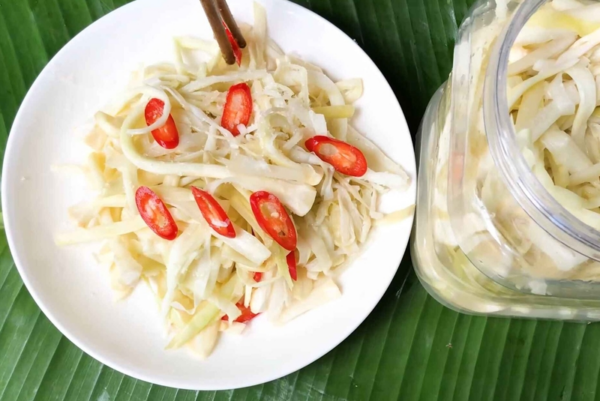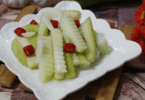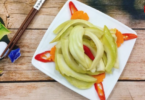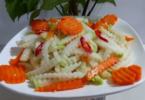Vietnamese Pickled Wild Water Lily Stems – A Crispy Delight from Vietnam’s Rivers
Bon Bon Muoi Chua is a light, crunchy, and slightly sour side dish made from the tender stems of wild water lilies. Popular in the Mekong Delta of Vietnam, this rustic pickle is both refreshing and easy to prepare at home. In this article, VNIFood will guide you through the full process, simple ingredients, and delicious ways to enjoy this unique part of Vietnamese cuisine.
What Is Vietnamese Pickled Wild Water Lily Stems?

Vietnamese pickled wild water lily stems, or Bon Bon Muoi Chua, is a traditional side dish made by fermenting the young, tender stems of wild water lilies in a light brine of salt, sugar, and water. Commonly found in the Mekong Delta region of Vietnam, especially in provinces like Can Tho or Soc Trang, this dish is loved for its natural crunch, mild sourness, and refreshing flavor. The water lily stems, called “Bon Bon” in Vietnamese, are peeled, cut, and soaked until they develop a pleasant tang while keeping their juicy texture. Often enjoyed with rice, grilled fish, or in salads, Bon Bon Muoi Chua is not just a condiment — it’s a reflection of the resourceful and nature-connected spirit of Vietnamese countryside cuisine.
Ingredients You’ll Need
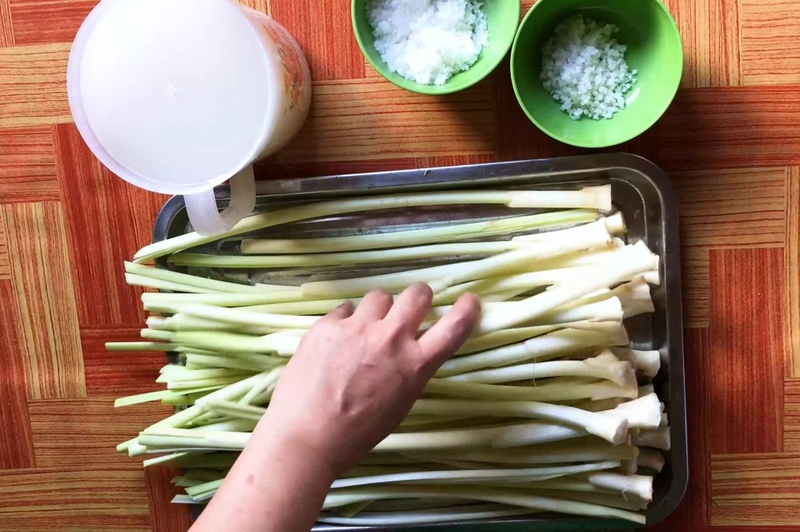
- 500g wild water lily stems
- 1 tablespoon salt
- 1 tablespoon sugar
- 200ml rice rinse water
- 2 cloves garlic
- 1 small red chili
- 1 clean glass jar
The Pickling Process
Step 1: Prepare the Wild Water Lily Stems

- Rinse thoroughly: Wash the wild water lily stems under clean running water to remove any dirt or mud.
- Peel if needed: If the outer layer feels tough, peel it off to get to the tender core.
- Cut into pieces: Slice the stems into lengths of 6–8 cm, which is ideal for pickling and serving.
- Drain well: Let the stems sit in a colander or on a clean towel for 10–15 minutes to remove excess water.
Step 2: Make the Brine

- In a mixing bowl, combine the following:
- 200ml rice rinse water (or filtered water)
- 1 tablespoon salt
- 1 tablespoon sugar
- Stir until the salt and sugar are completely dissolved.
- Add the optional sliced garlic and chili if you want extra flavor.
Step 3: Pickle and Store

- Place the prepared bon bon stems into a clean glass jar (500–750ml capacity).
- Pour the cooled brine over the stems until they are fully submerged.
- Use a clean spoon to gently press the stems down if they float.
- Close the lid tightly and leave the jar at room temperature for 1 to 2 days.
- After 24 hours, taste to check the sourness. You can let it ferment longer if you want it more tangy.
- Once it reaches your preferred taste, store the jar in the fridge. This slows the fermentation and helps preserve freshness.
I’ve Tested This Recipe Again and Again
I still remember the first time I tried to pickle bon bon at home. It was during a trip back to my hometown in Soc Trang, where the canals run deep and the air smells faintly of mud and fresh herbs. My aunt had just come back from the fields with a basket of wild water lily stems, long and pale, still wet with morning dew.
I laughed nervously and said I’d try. That first batch? A disaster. I didn’t peel the stems properly — they were too fibrous. I used tap water straight from the faucet — the kind with too much chlorine — and the fermentation never kicked in. The stems just sat there, sad and soft, floating in salty water. No crunch. No tang. Nothing like the bon bon muoi chua I had grown up with.
Every day, I opened the jar, smelled the brine, pressed the stems down gently, and tasted a little. Some batches turned slimy. Others turned sour too fast. One jar even turned cloudy because I didn’t dry the stems enough.
By the time I reached the eighth batch, I had learned what most recipes never tell you:
- That patience is part of the flavor.
- That the crunch comes from peeling carefully and drying thoroughly.
- That the sourness is best when it builds slowly, with just the right warmth and balance.
- And that Bon Bon Muoi Chua isn’t just a dish — it’s a memory, a rhythm, a taste of river life.
That eighth jar? It was perfect. Crisp. Tangy. Fragrant. It brought back a memory of sitting on the wooden floor next to my grandmother, dipping pickled Bon Bon into a little bowl of fishing sauce with garlic and chilly, eating with our fingers, and smiling between bites.

Conclusion
Vietnamese pickled wild water lily stems (Bon Bon Muoi Chua) are a perfect example of how nature and tradition come together in Vietnamese cuisine. With their refreshing crunch, gentle sourness, and earthy aroma, these pickled stems add flavor and balance to any meal. Whether served with grilled fish, tossed in a salad, or enjoyed on their own, this dish brings the spirit of the Mekong Delta to your table.
Try making your own bon bon muoi chua at home with just a few ingredients and a clean jar. Post your pickled masterpiece on social media using the hashtag #VNIFood – we love to feature our readers! Explore more traditional Vietnamese condiments, salads, and side dishes.
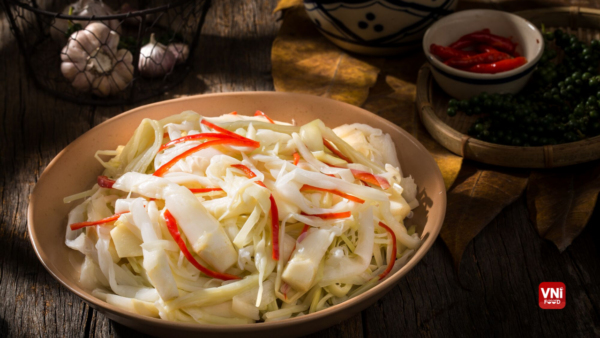
| Prep Time | 15 minutes |
| Servings |
people
|
- 500 g wild water lily stems
- 1 tablespoon Salt
- 1 tablespoon Sugar
- 200 ml rice rinse water
- 2 cloves garlic
- 1 Red Chili
- 1 Glass Jar
Ingredients
|

|
- Prepare the Wild Water Lily Stems Rinse thoroughly: Wash the wild water lily stems under clean running water to remove any dirt or mud. Peel if needed: If the outer layer feels tough, peel it off to get to the tender core. Cut into pieces: Slice the stems into lengths of 6–8 cm, which is ideal for pickling and serving. Drain well: Let the stems sit in a colander or on a clean towel for 10–15 minutes to remove excess water.

- Make the Brine In a mixing bowl, combine the following: 200ml rice rinse water (or filtered water) 1 tablespoon salt 1 tablespoon sugar Stir until the salt and sugar are completely dissolved. Add the optional sliced garlic and chili if you want extra flavor.
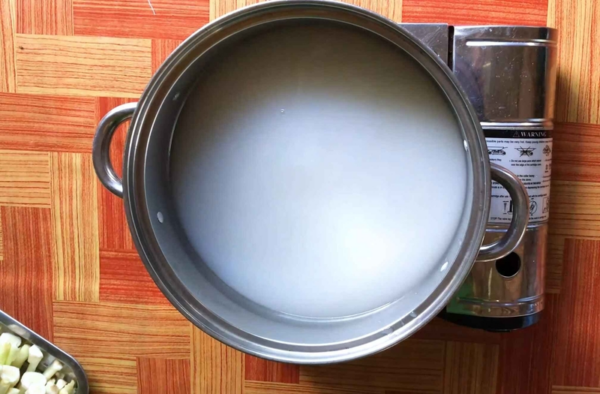
- Pickle and Store Place the prepared bon bon stems into a clean glass jar (500–750ml capacity). Pour the cooled brine over the stems until they are fully submerged. Use a clean spoon to gently press the stems down if they float. Close the lid tightly and leave the jar at room temperature for 1 to 2 days. After 24 hours, taste to check the sourness. You can let it ferment longer if you want it more tangy. Once it reaches your preferred taste, store the jar in the fridge. This slows the fermentation and helps preserve freshness.
